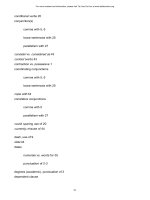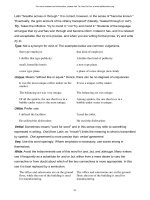The elements of coordinate geometry
Bạn đang xem bản rút gọn của tài liệu. Xem và tải ngay bản đầy đủ của tài liệu tại đây (21.23 MB, 452 trang )
www.pdfgrip.com
uTd-nu
y:
/o-
www.pdfgrip.com
www.pdfgrip.com
—
—
BY THE SAME AUTHOR.
A
Treatise on Elementary Dynamics.
Third Edition, Revised and Enlarged.
Crown
7s.
8vo.
6 c?.
Solutions of the Examples in the Elementary
Dynamics. Crown 8vo. 75. Qd.
The Elements
of Statics and Dynamics. Fcap. 8vo.
Elements of Statics. Fourth Edition, 4s. 6d.
II. Elements of Dynamics.
Fourth Ed., 3s. Qd.
two
Parts bound in one Volume.
The
7s. Qd.
Part
Part
I.
"Mr Loney shows that he knows how to combine perspicuity with
brevity in a remarkable degree.
One feature of both books is that
the author points out the portions that are adapted for a first reading,
and also those that are required for particular examinations."
GUdTd'tQjTt
PART
ELEMENTS OF
I.
STATICS.
"Students reading for the different examinations at Cambridge,
for the London University Matriculation, and intermediate Science,
for the Woolwich Entrance Examinations, will fi^nd a statement
of the part of the book to be read on this subject. Mr Loney deserves
much praise for the uniformly high standard he has shown in this his
Glasgow Herald.
latest effort."
and
Solutions of the Examples
Statics
and Dynamics.
in
the Elements of
Ex. Fcap. Svo.
7s. Qd.
Mechanics and Hydrostatics for Beginners.
Fcap. 8vo.
Third Edition.
Ex.
3s. Qd.
Parts. Crown 8vo. Second
and including the Solution of
Plane Trigonometry. In two
Edition.
Part
Triangles.
5s.
Part
II.
tions.
De
I.
up
to
Moivre's Theorem and the higher por-
3s. 6d.
The two Parts bound
in one
Yolume.
7s. Qd.
NATURE
says ; " ...It would be difficult to find a better introduction to Plane Trigonometry."
SCHOOL GUARDIAN
says; " ...It is a model of method,
and the simplicity of its explanations, its
numerous illustrative diagrams, and its large and varied collection of
exercises and examples combine to render it especially suitable for the
use of young pupils and private students.... The typography of the
volume is in every respect admirable...."
The
clearness,
and accuracy
;
www.pdfgrip.com
"
"
The SCHOOLMASTER says; " ...Mr Loney, using the soundest
judgment in his choice of matter, presents it with inimitable brevity
and clearness ; the publishers, too, have vied with the author in their
efforts to excel, and, as a result, the book is in every way worthy of
commendation."
The SCOTSMAN says " ...It expounds the subject with a skill
and fulness which give evidence of a peculiar experience in teaching
and of a special appreciation of the needs of students.
;
The
PRACTICAL TEACHER
competitors
it
cannot
says; "...Among its numerous
a deservedly high and popular
fail to attain
position."
The NATIONAL TEACHER (Ireland) says '• ...Seldom do such
books come under the notice of the reviewer. For conciseness and
clearness it has few compeers. It is deep without dullness ; comprehensive without wearisomeness. It comes before us with a newness
and freshness almost amounting to novelty...."
;
The SPEAKER says ; "Mr Loney as a writer of elementary
mathematical treatises maintains a high standard. His Elementary
Dynamics is marked by its brevity and clearness and deserves its
success.... The Cambridge Press has every reason to be proud of its
achievement."
The
made a
EDUCATIONAL REVIEW
says;
"...The author has not
special point of developing any one particular branch of the
subject, but his work is of uniform character throughout, and, we
may add, of uniformly good quality.... The arrangement of sections is
excellent ; the attention is clearly directed to important points, and
the style in which the book is produced may be fairly described as
luxurious."
GLASGOW HERALD
says ; " ...Mr Loney's text-book is sure
The
to be widely used in the several mathematical classes where sound work
The publisher's part of the work is also most admirably
is expected.
done.
CORRESPONDENT
says; "...It is well
The UNIVERSITY
written and the chapters relating to the changes of sign and magnitude of trigonometrical ratios in different quadrants are especially
deserving of praise...."
SCIENCE AND ART
says; "...In the analytical part of the
subject, considerable attention has been given to complex quantities,
and the author is to be congratulated on the lucid way in which he
has treated them.... The book may be strongly recommended as a
first-rate text-book."
aontion:
C.
J.
CLAY and SONS,
CAMBRIDGE UNIVERSITY PRESS WAREHOUSE,
AVE MARIA LANE.
(ffilagfloia:
263,
ARGTLE STREET.
www.pdfgrip.com
THE ELEMENTS
OP
COOEDINATE GEOMETRY.
www.pdfgrip.com
www.pdfgrip.com
THE ELEMENTS
OF
COOEDINATE aEOMETRY
BY
S.
L.
LONEY,
M.A.,
LATE FELLOW OF SIDNEY SUSSEX COLLEGE, CAMBRIDGE,
PROFESSOR AT THE ROYAL HOLLOWAY COLLEGE.
^^^l^^mU. MASS.
MATH, DEPTi
MACMILLAN AND
AND NEW YOEK.
1895
[All Bights reserved.']
www.pdfgrip.com
CO.
CTambrtlJse:
PRINTED BY
J.
&
C.
F.
CLAY,
AT THE UNIVEBSITY PRESS.
150553
www.pdfgrip.com
PKEFACE.
"TN
the following work I have tried to present the
elements of Coordinate Geometry in a manner
suitable
present
Junior Students.
The
book only deals with Cartesian and
Polar
Beginners and
for
Within these
Coordinates.
that the book
is fairly
limits I venture to
complete, and that no proposi-
tions of very great importance have
The Straight Line and
more
fully
since
it
is
hope
been omitted.
Circle have been treated
than the other portions of the subject,
generally in the
elementary conceptions
that beginners find great difficulties.
There are a large number of Examples, over 1100
in
all,
and they
character.
are,
in
The examples
general, of an
are especially
the earlier parts of the book.
www.pdfgrip.com
elementary
numerous in
PREFACE.
vi
for
reading
portions of the proof sheets, but especially to
Mr W.
I
J.
am much
indebted to several friends
Dobbs, M.A. who has kindly read the whole of the
book and made many valuable suggestions.
For any
shall
be
criticisms,
suggestions, or
grateful.
S.
EoTAIi
corrections, I
HOLLOWAY COLLEGE,
Egham, Surbey.
July
4, 1895.
www.pdfgrip.com
L.
LONEY.
CONTENTS.
CHAP.
I.
II.
Introduction.
...
Algebraic Kesults
Coordinates. Lengths of Straight Lines and
Areas of Triangles
Polar Coordinates
Equation to a Locus
Locus.
IV.
The Straight Line. Eect angular Coordinates
....
.
.
.
pendicular
.
.
.
Length of a perpendicular
.
.
.
Line.
.
.
51
.
.
66
.
.
.
loci
Equations representing two or more Straight
Lines
lines given
by one equation
Greneral equation of the second degree
VII.
42
Polar Equations and
Equations involving an arbitrary constant
Angle between two
39
58
Oblique Coordinates
VI.
31
.44
.
.
"
.
Bisectors of angles
Examples of
8
24
Straight line through two points
Angle between two given straight lines
Conditions that they may be parallel and per-
The Straight
1
19
III.
V
PAGE
Transformation of Coordinates
Invariants
.
.
.
.
.
73
80
88
90
94
109
115
www.pdfgrip.com
.
CONTENTS.
Vlii
PAGE
CHAP.
VIII.
The Circle
118
Equation to a tangent
126
137
Pole and polar
Equation to a circle in polar coordinates
Equation referred to oblique axes
Equations in terms of one variable
.
.150
.
160
Systems of Circles
Orthogonal circles
X.
148
.
.
.
IX.
.145
.
.
.
.
,
.
.160
.
Kadical axis
161
Coaxal circles
166
The Parabola
Conic Sections.
174
.
180
Equation to a tangent
Some
properties of the parabola
.
187
.
.
190
Pole and polar
195
Diameters
Equations in terms of one variable
XI.
The Parabola
{continued')
.
.198
.
....
Loci connected with the parabola
Three normals passing through a given point
Parabola referred to two tangents as axes
.
.
.
211
The Ellipse
225
Auxiliary circle and eccentric angle
Equation to a tangent
Some
Conjugate diameters
.231
.
.
....
237
......
249
.
.
properties of the ellipse
Pole and polar
Pour normals through any point
Examples of loci
XIII.
206
.217
.
XII.
206
.
.
.
.
.
.
www.pdfgrip.com
254
265
266
The Hyperbola
Asymptotes
Equation referred to the asymptotes as axes
One variable. Examples
242
271
284
.
296
299
.
CONTENTS.
CHAP.
XIV.
Polar Equation to, a Conic
IX
....
Polar equation to a tangent, polar, and normal
XV.
General Equation.
Tracing of Curves
Particular cases of conic sections
PAGE
306
313
,
322
....
.
322
Transformation of equation to centre as origin
Equation to asymptotes
Tracing a parabola
......
......
......
Tracing a central conic
.
.
.
.
.
.
Eccentricity and foci of general conic
XVI.
General Equation
Tangent
Conjugate diameters
326
.
329
332
338
342
349
349
352
Conies through the intersections of two conies
356
The equation S=Xuv
358
......
.......
General equation to the
j)air
of tangents
drawn
from any point
The director
The foci
The axes
circle
367
369
Lengths of straight lines drawn in given directions
to meet the conic
Conies passing through four 23oints
.
.
.
Conies touching four lines
The
LM=B?
conic
XVII. Miscellaneous Propositions
On
364
365
....
370
378
380
382
385
the four normals from any point to a central
conic
Confocal conies
.......
Circles of curvature
and contact of the third order
385
.
Envelopes
Answers
392
398
407
i
.
www.pdfgrip.com
—
xiii
ERKATA.
Page
„
,,
,,
87,
Ex.
27, line 4.
235, Ex. 18, line 3.
„
,,
282, Ex.
,,
3.
line 5.
For "JR" read " S."
For "odd" read "even."
Dele
"and Page
37,
Ex. 15."
For "transverse" read "conjugate."
www.pdfgrip.com
CHAPTER
I.
INTRODUCTION.
SOME ALGEBRAIC RESULTS.
1.
Quadratic Equations.
The
roots of the quad-
ratic equation
a'3^
may
easily
+ 6x + c =
be shewn to be
-
&
+
•JlP'
— 4ac
1
-b- s/b^ — 4:aG
'^"'^
•
2^
2i.
They are
and unequal,
equal, or imaginary,
according as the quantity b^—iac is positive, zero, or negative,
therefore real
i.e.
2.
and
according as
b^
=
4:ac.
Relations between the roots of any algebraic equation
of the terms of the equation.
the coejicients
If any equation be written so that the coefficient of the
highest term is unity, it is shewn in any treatise on Algebra
that
the sum of the roots is equal to the coefficient of
(1)
the second term with its sign changed,
(2)
the
at a time,
is
sum of the products of the roots, taken two
equal to the coefficient of the third term,
the sum of their products, taken three at a time,
(3)
equal to the coefficient of the fourth term with its sign
changed,
is
and so
L.
on.
e
www.pdfgrip.com
1
,
.
COORDINATE GEOMETRY.
Ex.
If
1.
a and
/3
ax'^
2.
If a,
b
+ bx + c = 0,
i.e.
x^
c
+ - x + ~ = 0,
a
—
b
a + p=
we have
Ex.
be the roots of the equation
a
c
^
and a^ = -.
and 7 be the roots of the cubic equation
j8,
ax^ + bx^ + cx + d=0,
i.e.
x^+-x^
of
a
we have
+-x + - = 0,
a
a
+ p + y:
a
^y + ya + a^=:and
o-Pl-
3.
shewn that the solution
It can easily be
of the
equations
+
a^x
h^y
+
G^z
= 0,
a^ + h^y + c^z = 0,
and
X
IS
y
~ ^2^1
^1^2
^1^2 ~ ^2^1
'^1^2
~ ^2^1
Determinant Notation.
4.
The
is called
quantity-
a determinant of the
second order and stands for the quantity
Exs.
(1)
d-yf
d^
^1,
h
a-})^
— aj)^,
so that
= Ob^^ — 6»2&i
\%^\ = 2x5-4x3 = 10-12=-2;
;'
|
!4, 5i
3,
(ii)
-7,
-4|
-6 = 3
X
(
-
6)
-{-
www.pdfgrip.com
7)
X
(
- 4) = 18 - 28 = -
10.
DETERMINANTS.
«!,
5.
The quantity
www.pdfgrip.com
COORDINATE GEOMETRY.
8.
The quantity
j
(h.1
^2>
%J
^4
61,
&2)
hi
h
^11
^25
^1) ^2
^3>
5
^3) ^4
called a determinant of the fourth order and stands for
the quantity
is
K
«i X
^2»
<^2>
h,
^3
^4
J
— Clo
^3> ^4
X
i^lJ
^35
C-,
^3}
\
1
1
&i,
+ 6^3
h
4
33
5
62J
X
^4!
C^
1
?
2
5
4
www.pdfgrip.com
&1,
cCj_
X
.
ELIMINATION.
5
Elimination.
Suppose
11.
we have
the two equations
+ a^y =
aj^x
(1),
\x +b^y ^0
two unknown quantities x and
between the
be some relation holding between the four
^or, from (1), we have
bi, and 63
(2),
y.
There must
coefficients
6*i, ctaj
•
and, from
(2),
we have
y~
%'
-=—
y
K
Equating these two values
i.e.
=-^
X
of -
we have
— ajb^ =
a-J)^
(3).
The result (3) is the condition that both the equations
and (2) should be true for the same values of x and y.
The process of finding this condition is called the eliminating of X and y from the equations (1) and (2), and the
result (3) is often called the eliminant of (1) and (2).
Using the notation of Art. 4, the result (3) may be
(1)
written in the form
1
)
'^
0.
is obtained from (1) and (2) by taking the
x and y in the order in which they occur in
the equations, placing them in this order to form a determinant, and equating it to zero.
This result
coefficients of
12.
we have
a-^x + a^y + a^^ =
\x+ h^y^ h^z =
G^x + G^y + C3S =
unknown quantities
Suppose, again, that
and
between the three
the three equations
(1),
(2),
(3),
x, y,
www.pdfgrip.com
and
z.
COORDINATE GEOMETRY.
6
By
dividing each equation by z
we have
three equations
X
between the two unknown quantities — and y
z
%,
www.pdfgrip.com
z
Two
of
ELIMINATION.
14.
and
If again
we have
the four equations
a-^x
+
dil/
+
cf'zZ
+ a^u =
0,
h^x
+
h^y
+
b^z
+
b^u
=
0,
Ci«;
+
c^i/
+
G^z
+
c^u
=
0,
djX + d^y
+
d.^z
+
d^ — 0,
could be shewn that the result of eliminating the four
quantities cc, y, z^ and u is the determinant
it
«1J
www.pdfgrip.com
CHAPTER
COORDINATES.
II.
LENGTHS OF STRAIGHT LINES AND
AREAS OF TRIANGLES.
OX
07
and
15. Coordinates. Let
be two fixed
The line
is
straight lines in the plane of the paper.
the axis of y, whilst the
called the axis of cc, the line
two together are called the axes of coordinates.
OX
OY
The point
is
called the origin of coordinates or,
more
shortly, the origin.
F
From any point in the
plane draw a straight line
OF to meet OX
M.
The distance OM is called
the Abscissa, and the distance
parallel to
in
MP the Ordinate of the point
P, whilst the abscissa and the
ordinate together are called
its Coordinates.
OX
Distances measured parallel to
or without a suffix, {e.g.Xj, x.-^... x\
measured parallel to OY are called
suffix, (e.g.
2/i, 2/2,---
If the distances
the coordinates of
2/'.
y",---)-
OM and MP
P are,
are called a?, with
x",...), and distances
y, with or without a
be respectively x and ?/,
by the symbol
for brevity, denoted
{x, y).
Conversely, when we are given that the coordinates of
For from
we
a point
are (x, y) we know its position.
{—x) along
and
have only to measure a distance
P
OM
www.pdfgrip.com
OX
COORDINATES.
then from 21 measure a distance
9
MP
OY
{=y) parallel to
arrive at the position of the point P.
For example
be equal to the unit of length and
in the figure, if
and we
MP= WM,
OM
P is the point (1, 2).
Produce XO backwards to form
then
the line OX' and
backwards to become OY'. In Analytical Geometry
we have the same rule as to signs that the student has
already met with in Trigonometry.
Lines measured parallel to OX are positive whilst those
measured parallel to OX' are negative ; lines measured
parallel to OY are positive and those parallel to OY' are
16.
YO
negative.
quadrant YOX' and P^M^, drawn
y, meet OX' in M^^ and if the
numerical values of the quantities OM^ and J/aPg be a
and h, the coordinates of P are {-a and h) and the position
of Pg is given by the symbol (—a, h).
If
P2 b® i^
*li®
parallel to the axis of
Similarly, if P3 be in the third quadrant X'OY', both of
coordinates are negative, and, if the numerical lengths
of Oi/3 and J/3P3 be c and d, then P3 is denoted by the
its
symbol (—
c,
Finally,
positive
17.
and
Ex.
(i)
—
d).
in the fourth quadrant its abscissa is
its ordinate is negative.
if
P4
lie
Lay down on "paper
(2,
-1),
(ii)
(-3,
the position of the points
2),
and
(iii)
(-2, -3).
To get the first point we measure a distance 2 along OX and then
a distance 1 parallel to OF'; we thus arrive at the required point.
To get the second point, we measure a distance 3 along OX', and
then 2 parallel to OY.
To get the third point, we measure 2 along OX' and then
3 parallel to OT.
These three points are respectively the points P4 P., and Pg in
,
,
the figure of Art. 15.
18. When the axes of coordinates are as in the figure
of Art. 15, not at right angles, they are said to be Oblique
Axes, and the angle between their two positive directions
and 07, i.e. the angle XOY, is generally denoted by
OX
the Greek letter
w.
www.pdfgrip.com









